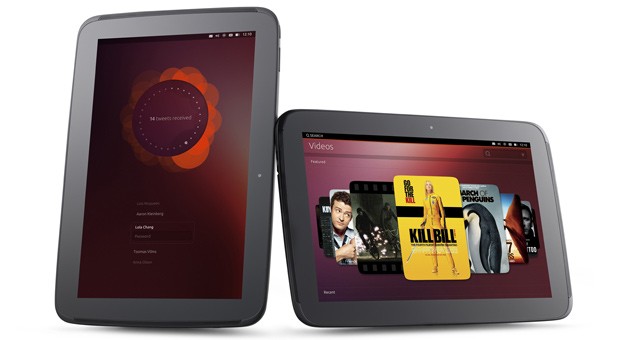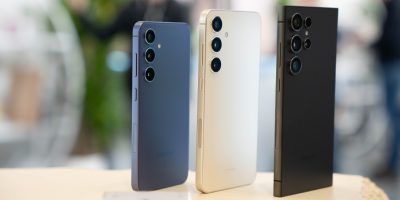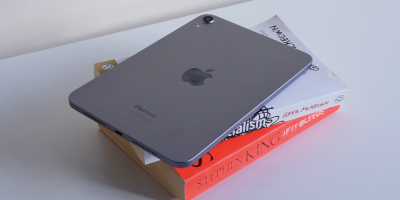With all the craziness going on in New York City right now you’d think there is nothing else happening. Well, I’m glad to say that there is more happening. Remember that countdown timer Canonical posted yesterday? Well, it wasn’t exactly for an HTC tablet (as cool as that would have been) but the company — which makes the Linux distribution Ubuntu — has some exciting news regardless.
Ubuntu for Tablets has been introduced, and it’s an implementation that has been built from the ground up with multi-tasking in mind. The biggest feature to drive that point home is SideStage. With it, you’ll be able to pull up the phone interface of an app from the right edge of your display so you can use it while doing something else. For instance, I could be Skyping with my friend on the left, and have a smaller pane offset to the right for checking Twitter.
SideStage can come in as an overlay or as an adjustable split-screen item, not unlike the implementation you’ll find on Samsung’s Galaxy Note devices or on Windows 8 Pro. What’s even cooler is that the tablet app in SideStage can automatically flipped over to the phone part, and the user interface will change accordingly (assuming there’s a phone interface for that particular app baked in).
In the video above, Canonical shows how you can converge the various aspects of your computing life with one seamless experience. Dock your phone with your tablet, and you’ll be whisked into the tablet interface while your phone apps continue running off to the side in Side Stage. From there, if you were to connect a keyboard and mouse to the tablet you can use the full Ubuntu experience as you would on traditional desktops and laptops. Then, take your remote and turn your television on for that same Ubuntu experience on the big screen.
So why is this so important to Android? Well, those of you who own the Nexus 7 and Nexus 10 will be able to see how this works for yourself once Canonical brings out working preview code for those devices this Thursday. It’s a nerd’s wet-dream come true, and we can’t wait to see how this all pans out. Watch the video above, and read on for full press details.
London, 19th February 2013
Canonical today presented Ubuntus tablet interface — the next step towards one unified family of experiences for personal computing on phones, tablets, PCs and TVs.
”Multi-tasking productivity meets elegance and rigorous security in our tablet experience,” said Mark Shuttleworth, founder of Ubuntu and Canonical. ”Our family of interfaces now scales across all screens, so your phone can provide tablet, PC and TV experiences when you dock it. That’s unique to Ubuntu and it’s the future of personal computing.”
”Fashion industry friends say the Ubuntu phone and tablet are the most beautiful interfaces they’ve seen for touch,” said Ivo Weevers, who leads the Canonical design team. ”We’re inspired by the twin goals of style and usability, and working with developers who are motivated to create the best possible experience for friends, family and industry.”
The new tablet design doesnt just raise the bar for elegant presentation, it breaks new ground in design and engineering, featuring:
- Real multitasking: Uniquely, Ubuntu allows a phone app on the screen at the same time as a tablet app. The Ubuntu side stage was invented both to enable efficient multitasking and to improve the usability of phone apps on tablets.
- Secure multi-user: Multiple accounts on one tablet with full encryption for personal data, combined with the trusted Ubuntu security model that is widely used in banks, governments and sensitive environments, making it ideal for work and family use.
- Voice controlled HUD productivity: The Heads-Up Display, unique to Ubuntu, makes it fast and easy to do complex things on touch devices, and transforms touch interfaces for rich applications, bringing all the power of the PC to your tablet.
- Edge magic for cleaner apps: Screen edges are used for navigation between apps, settings and controls. That makes for less clutter, more content, and sleeker hardware. No physical or soft buttons are required. Its pure touch elegance.
- Content focus: Media is neatly presented on the customisable home screen, which can search hundreds of sources. Perfect for carriers and content owners that want to highlight their own content, while still providing access to a global catalogue.
- Full convergence: The tablet interface is presented by exactly the same OS and code that provides the phone, PC and TV interfaces, enabling true device convergence. Ubuntu is uniquely designed to scale smoothly across all form factors.
The Ubuntu tablet interface supports screen sizes from 6 to 20 and resolutions from 100 to 450 PPI. The tablet fits perfectly between phone and PC in the Ubuntu family says Oren Horev, lead designer for the Ubuntu tablet experience. Not only do we integrate phone apps in a distinctive way, we shift from tablet to PC very smoothly in convergence devices.
On high end silicon, Ubuntu offers a full PC experience when the tablet is docked to a keyboard, with access to remote Windows applications over standard protocols from Microsoft, Citrix, VMWare and Wyse. An Ubuntu tablet is a secure thin client that can be managed with the same tools as any Ubuntu server or desktop, said Stephane Verdy, who leads enterprise desktop and thin client products at Canonical. We are delighted to support partners on touch and mobile thin clients for the enterprise market.
Even without chipset-specific optimisation, Ubuntu performs beautifully on entry level hardware. Our four-year engagement with ARM has shaped Ubuntu for mobile said Rick Spencer, VP Ubuntu Engineering at Canonical. We benefit from the huge number of contributing developers who run Ubuntu every day, many of whom are moving to touch devices as their primary development environment.
For silicon vendors, Ubuntu is compatible with any Linux-oriented Board Support Package (BSP). This means Ubuntu is easy to enable on most chipset designs that are currently running Android. Ubuntu and Android are the two platforms enabled by Linaro members.
The Touch Developer Preview of Ubuntu will be published on the 21st February 2013 with installation instructions for the Nexus 7 and Nexus 10 tablet devices as well as smartphones such as the Nexus 4 and Galaxy Nexus. Installable images and source code will be available from developer.ubuntu.com.
The Preview SDK, which currently supports phone app development, will now be updated to support tablet apps as well. Uniquely, on Ubuntu, developers can create a single application that works on the phone, tablet, PC and TV because it is the same system and all services work across all form factors.
Visit us at Mobile World Congress: Booth Number: 81D30, App Planet Hall 8.1.
The Canonical team will be available to install Ubuntu on your phones and tablets at Mobile World Congress. Note: Ubuntu Touch Developer Preview is a developer build and not a consumer-ready release.
About Canonical and Ubuntu
Canonical is the company behind Ubuntu and the leading provider of services for Ubuntu deployments in the enterprise. With global teams of developers, support staff and engineering centres, Canonical is uniquely positioned to help partners and customers make the most of Ubuntu. It also operates Ubuntu One, a cross-platform personal cloud service for consumers. Canonical is a privately held company.
Ubuntu is a free, open-source platform for client, server and cloud computing. It is the most widely used Linux on the top 1000 websites by traffic, the reference platform for OpenStack deployments, the most popular guest OS on public clouds, and ships on PCs from Dell, Lenovo, HP and other brands. Since its launch in 2004, it has become the preferred choice for open desktop and scale-out computing, from Fortune 500 companies to hardware makers, content providers, software developers and consumers.










Might just pick up a nexus 7 to try this out
Was thinking the same, actually…
Aaaaaawe no HTC tablet for ubuntu.. that’d have been awesome..
isn’t that feature pretty much like Samsung’s dual screen feature on the note 2? but its actually better on the note 2
“not unlike the implementation you’ll find on Samsung’s Galaxy Note devices or on Windows 8 Pro.”
Did you read any of the article?
sorry didnt have time to read it whilst i was in college
Then you obviously have a lot to learn, but at least you are trying.
Yeah, and the phone docking to a tablet, it’s the Asus Padfone.
The tablet turning to a laptop? The Asus Transformer Pads.
Both reminding me of Motorola’s laptop dock.
An OS that goes from mobiles to smart tv’s? That sounds just like Android to me.
Nothing really unique…
Still, if it’s smooth and gets a lot of apps, why not, it looks good.
If there is anything that could pry me away from android it would be this. I’d like to have dual boot though
I knew no HTC Tablet. They said it themselves their throwing in the towel with Tablets after the Jetstream epically failed.
Does it support flash?
if mobile ubuntu is really as amazing as it sounds, I may actually leave android. never thought that would happen. they needed someone else to do the demonstration videos though. i don’t know if it’s his voice or constant speaking with his hands, but I’m not feeling that dude
I disagree. That man is out of this world.
so sad that no OEM wants to build a ubooty tablet…maybe lack of a true consumer linux community is the reason. True story.
Wonder if I can load it onto my EVO 4G View tablet since HTC dumped support on it right out of the gate.
I’m very unhappy with the result of the “convergence” philosophy on the desktop. I use Ubuntu (munged as much as possible to make it useful), but I hate it. It’s a hugely dumb idea. Maybe the small-screen manifestation will be usable, but I’m not optimistic.
If you hate ubuntu then may I suggest you take a look at the likes of PCLinuxOS and its derivatives you may find something that suites you better I personally use a gnome 2 version personally.
There’s a lot of possibilities with this, native multitasking, from the kernel, is sooo good.
This may be a dumb question, but will it have the Play store on it. If not, this is the only reason I would not put this on my tablet.
It’s a desktop Os. No don’t think it would. It will probably have the synaptic package manager or Ubuntu’s store. As he said though, it has thousands of powerful applications. If u have used Ubuntu before you know that this is pretty serious. I’m wondering if full desktop programs would really work on it with the tablet having an arm chip and all.
Only apps to work would be those compiled to work on ARM based systems so no not all the desktop apps would work.
he said how “fast” it is about a million times. I really doubt it’ll be fast on my nexus 7